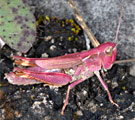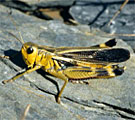Gryllotalpa gryllotalpa (Linnaeus, 1758)
![Gryllotalpa gryllotalpa: Male (e.l. rearing, near Stuttgart, larva in June 2019, adult in August 2020) [S] Gryllotalpa gryllotalpa: Male (e.l. rearing, near Stuttgart, larva in June 2019, adult in August 2020) [S]](thumbs/gryllidae/gryllotalpa_im2020.jpg)
![Gryllotalpa gryllotalpa: Male (e.l. rearing, near Stuttgart, larva in June 2019, adult in August 2020) [S] Gryllotalpa gryllotalpa: Male (e.l. rearing, near Stuttgart, larva in June 2019, adult in August 2020) [S]](thumbs/gryllidae/gryllotalpa_2im2020.jpg)
![Gryllotalpa gryllotalpa: Male (e.l. rearing, near Stuttgart, larva in June 2019, adult in August 2020) [S] Gryllotalpa gryllotalpa: Male (e.l. rearing, near Stuttgart, larva in June 2019, adult in August 2020) [S]](thumbs/gryllidae/gryllotalpa_3im2020.jpg)
![Gryllotalpa gryllotalpa: Male (e.l. rearing, near Stuttgart, larva in June 2019, adult in August 2020) [S] Gryllotalpa gryllotalpa: Male (e.l. rearing, near Stuttgart, larva in June 2019, adult in August 2020) [S]](thumbs/gryllidae/gryllotalpa_4im2020.jpg)
![Gryllotalpa gryllotalpa: Male digging into the soil (e.l. rearing, near Stuttgart, larva in June 2019, adult in August 2020) [S] Gryllotalpa gryllotalpa: Male digging into the soil (e.l. rearing, near Stuttgart, larva in June 2019, adult in August 2020) [S]](thumbs/gryllidae/gryllotalpa_5im2020.jpg)
![Gryllotalpa gryllotalpa: Male digging into the soil (e.l. rearing, near Stuttgart, larva in June 2019, adult in August 2020) [S] Gryllotalpa gryllotalpa: Male digging into the soil (e.l. rearing, near Stuttgart, larva in June 2019, adult in August 2020) [S]](thumbs/gryllidae/gryllotalpa_6im2020.jpg)
![Gryllotalpa gryllotalpa: Male (e.l. rearing, near Stuttgart, larva in June 2019, adult in August 2020) [S] Gryllotalpa gryllotalpa: Male (e.l. rearing, near Stuttgart, larva in June 2019, adult in August 2020) [S]](thumbs/gryllidae/gryllotalpa_7im2020.jpg)
![Gryllotalpa gryllotalpa: Male (e.l. rearing, near Stuttgart, larva in June 2019, adult in August 2020) [S] Gryllotalpa gryllotalpa: Male (e.l. rearing, near Stuttgart, larva in June 2019, adult in August 2020) [S]](thumbs/gryllidae/gryllotalpa_8im2020.jpg)
![Gryllotalpa gryllotalpa: Male (e.l. rearing, near Stuttgart, larva in June 2019, adult in August 2020) [S] Gryllotalpa gryllotalpa: Male (e.l. rearing, near Stuttgart, larva in June 2019, adult in August 2020) [S]](thumbs/gryllidae/gryllotalpa_9im2020.jpg)
![Gryllotalpa gryllotalpa: Male (e.l. rearing, near Stuttgart, larva in June 2019, adult in August 2020) [S] Gryllotalpa gryllotalpa: Male (e.l. rearing, near Stuttgart, larva in June 2019, adult in August 2020) [S]](thumbs/gryllidae/gryllotalpa_10im2020.jpg)
![Gryllotalpa gryllotalpa: Male (e.l. rearing, near Stuttgart, larva in June 2019, adult in August 2020) [S] Gryllotalpa gryllotalpa: Male (e.l. rearing, near Stuttgart, larva in June 2019, adult in August 2020) [S]](thumbs/gryllidae/gryllotalpa_11im2020.jpg)
![Gryllotalpa gryllotalpa: Relatively small larva (near Stuttgart, June 2019) [S] Gryllotalpa gryllotalpa: Relatively small larva (near Stuttgart, June 2019) [S]](thumbs/gryllidae/gryllotalpa_12im2020.jpg)
![Gryllotalpa gryllotalpa: Relatively small larva (near Stuttgart, June 2019) [S] Gryllotalpa gryllotalpa: Relatively small larva (near Stuttgart, June 2019) [S]](thumbs/gryllidae/gryllotalpa_13im2020.jpg)
![Gryllotalpa gryllotalpa: Half-grown larva (e.l. rearing, near Stuttgart, young larva in June 2019, December 2019) [S] Gryllotalpa gryllotalpa: Half-grown larva (e.l. rearing, near Stuttgart, young larva in June 2019, December 2019) [S]](thumbs/gryllidae/gryllotalpa_14im2020.jpg)
Nutrition:
The species feeds on other insects, worms and other animals. Plants (roots etc.) form only a comparatively small part of the total food spectrum. In rearing the animals can be kept vegetarian, e.g. with half potatoes or crude carrots.
Habitat:
Gryllotalpa gryllotalpa inhabits sites with easily diggable, not too dry soil. It is often found in wetlands, along shores or in extensively managed gardens. It has already been pushed back from most of the nowadays too intensely managed arable land.
Life cycle:
The larvae hibernate usually at least twice. They become sexually mature usually not until the third year. Mating occurs in May and June. The females take care for the eggs by guarding and protecting them from fungi.
The animals are found only rarely outside their tunnels. They can swim and reputedly even fly.
Remarks:
Gryllotalpa gryllotalpa is quite widespread in Europe (not in N-Scandinavia) and W-Asia, but only locally numerous . In S-Europe confusion is possible with closely related species.


